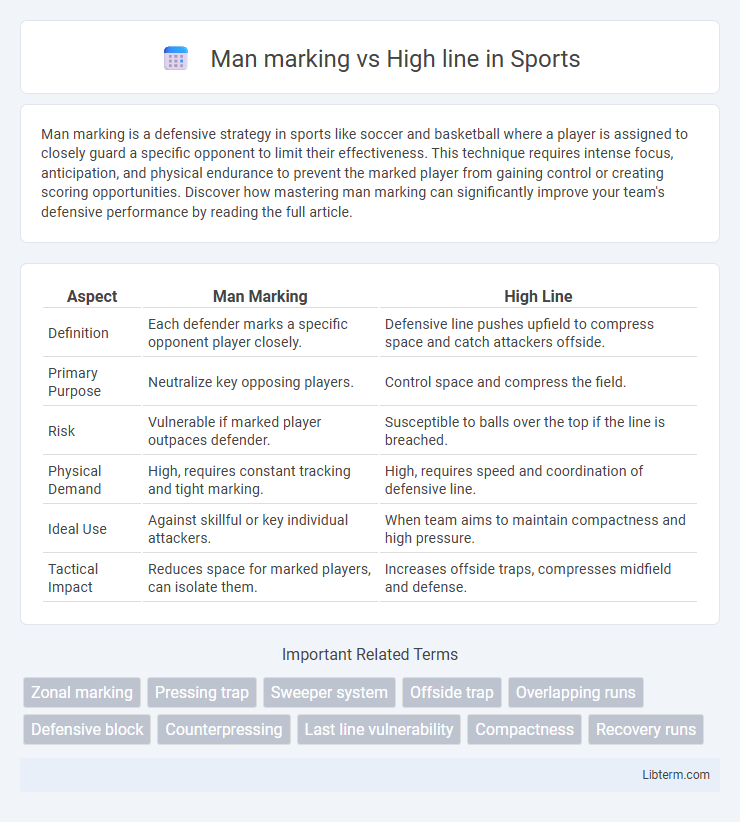Man marking is a defensive strategy in sports like soccer and basketball where a player is assigned to closely guard a specific opponent to limit their effectiveness. This technique requires intense focus, anticipation, and physical endurance to prevent the marked player from gaining control or creating scoring opportunities. Discover how mastering man marking can significantly improve your team's defensive performance by reading the full article.
Table of Comparison
| Aspect | Man Marking | High Line |
|---|---|---|
| Definition | Each defender marks a specific opponent player closely. | Defensive line pushes upfield to compress space and catch attackers offside. |
| Primary Purpose | Neutralize key opposing players. | Control space and compress the field. |
| Risk | Vulnerable if marked player outpaces defender. | Susceptible to balls over the top if the line is breached. |
| Physical Demand | High, requires constant tracking and tight marking. | High, requires speed and coordination of defensive line. |
| Ideal Use | Against skillful or key individual attackers. | When team aims to maintain compactness and high pressure. |
| Tactical Impact | Reduces space for marked players, can isolate them. | Increases offside traps, compresses midfield and defense. |
Introduction to Defensive Strategies in Football
Man marking involves assigning each defender to closely follow a specific opponent, preventing them from receiving the ball or making effective plays. High line defense pushes the defensive line further upfield to compress playing space, applying pressure on attackers and enabling offside traps. Both strategies require precise coordination and tactical awareness to disrupt the opposing team's offensive flow effectively.
What is Man Marking?
Man marking is a defensive strategy in soccer where each defender is assigned to closely track and neutralize a specific opponent, limiting their influence on the game. This approach contrasts with a high line defense, which involves defenders pushing up the field to compress space and catch attackers offside. Man marking requires intense individual focus and stamina to shadow opponents, preventing key players from receiving the ball or making impactful plays.
What is a High Defensive Line?
A high defensive line in football is a tactical approach where defenders position themselves closer to the midfield, compressing the playing area and limiting the opponent's time on the ball. This strategy helps teams maintain pressure, disrupt passing lanes, and enable quick transitions to attack, but it also risks vulnerability to fast counterattacks behind the defense. Compared to man marking, which focuses on closely tracking specific opponents, a high defensive line emphasizes spatial control and collective positioning to dominate the opponent's offensive build-up.
Key Differences: Man Marking vs High Line
Man marking involves defenders closely tracking individual opponents to limit their influence, enhancing defensive precision and reducing space for attackers. The high line strategy positions the defensive line further up the pitch to compress space and apply pressure, increasing the risk of vulnerability to through balls behind the defense. Key differences include personal opponent focus in man marking versus spatial control in the high line, with man marking emphasizing individual accountability and the high line relying on team coordination and offside traps.
Advantages of Man Marking
Man marking offers superior individual accountability by assigning specific defenders to closely track key opponents, reducing their influence on the game. This defensive strategy allows for tailored pressure on dangerous attackers, disrupting their rhythm and limiting scoring opportunities. Man marking enhances team coordination by ensuring each player assumes clear responsibility, minimizing defensive lapses and maintaining organized containment.
Advantages of a High Line
High line defensive strategies provide superior spatial control by pushing the defensive line higher up the pitch, effectively reducing the opponent's attacking space and limiting through balls. This approach enhances offside trap effectiveness, making it harder for attackers to exploit gaps compared to traditional man marking. Teams employing a high line benefit from increased defensive cohesion and quicker transition into attack, optimizing overall team compactness and pressing intensity.
Tactical Risks: Breaking Down the Weaknesses
Man marking risks include susceptibility to off-the-ball movements and creating gaps when defenders lose track of their assigned player, leading to defensive disorganization. High line tactics expose vulnerabilities to fast counter-attacks and through balls, as vast spaces behind the defense invite exploitation by pacey attackers. Both strategies demand exceptional communication and situational awareness; failure to maintain these aspects often results in conceding goal-scoring opportunities.
Player Roles and Responsibilities
In man marking, defenders are tasked with closely tracking specific opponents, requiring high individual concentration and physical endurance to limit their influence on the game. High line defense demands coordinated positioning from the entire backline, emphasizing spatial awareness and collective responsibility to maintain a compact, elevated defensive shape that compresses the playing area. Both strategies require defenders to adapt their roles dynamically, with man marking focusing on tight man-to-man pressure and high line defenders prioritizing offside traps and quick recovery runs.
Famous Teams and Managers Using Each Tactic
Famous teams like Chelsea under Antonio Conte have effectively implemented man marking, utilizing strict player-to-player defensive assignments to neutralize key opponents. High line tactics gained prominence through managers like Pep Guardiola at Manchester City, where a compact, pressing defense compresses space and maintains possession high up the pitch. Both strategies reflect distinct philosophies, with man marking emphasizing individual accountability and the high line focusing on team shape and pressing intensity.
Choosing the Right System: Situational Effectiveness
Man marking excels in tightly controlling key opposition players, especially in one-on-one defensive scenarios where individual accountability is crucial. High line defenses maximize spatial control by compressing the playing area and applying collective pressure, effective primarily against teams reliant on quick passes and short build-up play. Choosing between man marking and a high line depends on factors such as opponent's tactical style, player attributes, and game context, with man marking suited for neutralizing specific threats and high lines ideal for proactive territorial dominance.
Man marking Infographic

 libterm.com
libterm.com